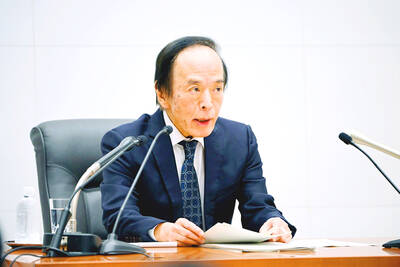Memory module supplier Adata Technology Co (威剛科技) is to unveil its first voice-controlled speaker at next week’s Computex Taipei, the company said yesterday, in its latest move to diversify into the artificial intelligence (AI) business.
The New Taipei City-based company plans to release the first batch of the smart speakers, which respond to Mandarin speech, next quarter in Taiwan and China in collaboration with Chunghwa Telecom Co (中華電信), Adata chairman Simon Chen (陳立白) told reporters.
“With Alibaba Group Holding Ltd (阿里巴巴), Baidu Inc (百度) and Tencent Holdings Ltd (騰訊) pushing to sell their own voice-controlled speakers, there will be explosive growth in demand from Chinese-speaking communities from the fourth quarter of this year,” Chen said.
The affordable price tag is a factor behind the favorable growth prospects for Adata’s voice-activated AI device, Chen said.
Adata is well-positioned to benefit from the rapidly growing demand for such voice assistants in Chinese-speaking communities, where established players, such as Amazon.com Inc and Google, are absent due to the high barrier of entry posed by Chinese speech recognition, he said.
Google Home and Amazon Alexa support a number of languages, but not Mandarin.
Adata aims to capture the top spot in the local smart speaker market, Chen said.
Adata chose global chipmakers over Hsinchu-based MediaTek Inc (聯發科) to supply chips for its first-generation of smart speakers, but it would use MediaTek chips in its next-generation AI assistant devices, the company said.
MediaTek is the world’s biggest chip supplier for smart speakers with a more than 70 percent market share. The company counts Google LLC and Amazon.com as its major clients.
Commenting on Adata’s core memory module businesses, Chen said the company’s profit would climb quarterly this year as DRAM chip prices are expected to remain flat, or increase slightly in the second half due to seasonal demand.
Chen said he is optimistic about the DRAM market’s outlook this year and next year, given healthy demand-supply dynamics.
DRAM for servers are to see the strongest demand among three major segments, and the strength would carry into the next one to two years, he said.
Demand from mobile phone makers is also on the rise, as this year’s models have much bigger memory space than last year’s, Chen said.
Significant growth in DRAM chips used in gaming PCs would help stabilize standard DRAM chip demand, he added.
DRAM modules contributed about 54 percent to Adata’s revenue of NT$32.23 billion (US$1.07 billion) last year, up from 38 percent in 2016.
Solid-state drives for PCs, micro SD cards and flash memory cards, which contain NAND flash memory chips, made up about 20 percent of total revenue.
Prices of NAND flash memory chips are likely to stabilize in the remainder of this year, given weakening oversupply pressure, Chen said.

Taiwan Semiconductor Manufacturing Co (TSMC, 台積電) last week recorded an increase in the number of shareholders to the highest in almost eight months, despite its share price falling 3.38 percent from the previous week, Taiwan Stock Exchange data released on Saturday showed. As of Friday, TSMC had 1.88 million shareholders, the most since the week of April 25 and an increase of 31,870 from the previous week, the data showed. The number of shareholders jumped despite a drop of NT$50 (US$1.59), or 3.38 percent, in TSMC’s share price from a week earlier to NT$1,430, as investors took profits from their earlier gains

In a high-security Shenzhen laboratory, Chinese scientists have built what Washington has spent years trying to prevent: a prototype of a machine capable of producing the cutting-edge semiconductor chips that power artificial intelligence (AI), smartphones and weapons central to Western military dominance, Reuters has learned. Completed early this year and undergoing testing, the prototype fills nearly an entire factory floor. It was built by a team of former engineers from Dutch semiconductor giant ASML who reverse-engineered the company’s extreme ultraviolet lithography (EUV) machines, according to two people with knowledge of the project. EUV machines sit at the heart of a technological Cold

TAIWAN VALUE CHAIN: Foxtron is to fully own Luxgen following the transaction and it plans to launch a new electric model, the Foxtron Bria, in Taiwan next year Yulon Motor Co (裕隆汽車) yesterday said that its board of directors approved the disposal of its electric vehicle (EV) unit, Luxgen Motor Co (納智捷汽車), to Foxtron Vehicle Technologies Co (鴻華先進) for NT$787.6 million (US$24.98 million). Foxtron, a half-half joint venture between Yulon affiliate Hua-Chuang Automobile Information Technical Center Co (華創車電) and Hon Hai Precision Industry Co (鴻海精密), expects to wrap up the deal in the first quarter of next year. Foxtron would fully own Luxgen following the transaction, including five car distributing companies, outlets and all employees. The deal is subject to the approval of the Fair Trade Commission, Foxtron said. “Foxtron will be

INFLATION CONSIDERATION: The BOJ governor said that it would ‘keep making appropriate decisions’ and would adjust depending on the economy and prices The Bank of Japan (BOJ) yesterday raised its benchmark interest rate to the highest in 30 years and said more increases are in the pipeline if conditions allow, in a sign of growing conviction that it can attain the stable inflation target it has pursued for more than a decade. Bank of Japan Governor Kazuo Ueda’s policy board increased the rate by 0.2 percentage points to 0.75 percent, in a unanimous decision, the bank said in a statement. The central bank cited the rising likelihood of its economic outlook being realized. The rate change was expected by all 50 economists surveyed by Bloomberg. The